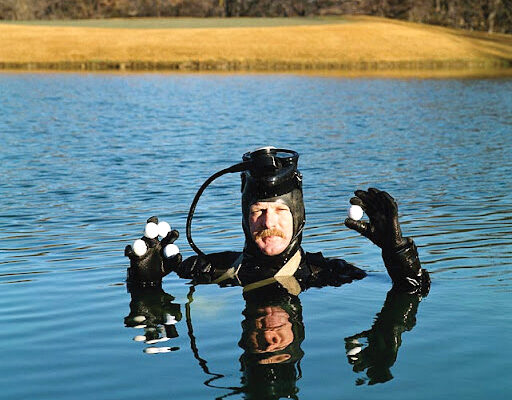The Found Art of Lost Balls

Lost golf balls frustrate us all and present an environmental challenge. But creative solutions are at hand.
If you plunked a couple of Pro V1s into the drink on your last round, you’ve got plenty of company. Ditto if you sliced a few into some deep, ball-swallowing rough. The average golfer loses about three balls per round. With 47.2 million of us playing the game in the U.S., that is, well, a lot of swear words muttered — and some 400 million balls a year sacrificed to the unforgiving gods that preside over golf course ponds and rough.
Lost balls are a problem on many levels. At best, plunking into a water hazard will cost you a one-stroke penalty and as much as $5 for the ball, not to mention chagrin, embarrassment and/or some fruitless time trying to fish it out while your mates and the next foursome glare at your sad effort. (Reminder: Rule 18.2 gives you three minutes, not the old five, for said fruitless search. Just hit a provisional and get on with life.)
But beyond pride and pocketbook, we’re paying an environmental cost for all those lost golf balls. In other words, it’s not only about you; it’s about the planet.
“Water adds beauty, strategy and consequence to golf,” says environmental consultant Parker Anderson of Santa Barbara-based Greener Golf, “but it also collects our misses. Inevitably, golf balls that end up in lakes, rivers and the ocean slowly break down, leaching microplastics and fossil-fuel-based toxins into ecosystems. The same microplastics linked to hormone disruption in wildlife are now found in humans at startling high rates.”
But wait a second, you’re surely thinking. What’s more inert than golf balls? And aren’t they waterproof? Yes, they’re durable and highly water-resistant. But waterproof? Nah. And therein lies the problem. Golf balls are basically little dimpled spheres composed of fossil-fuel-based products — a synthetic rubber called polybutadiene sheathed in thermoplastic resins and encased in an ionomer resin known as Surlyn. That’s a recipe made for performance, resilience and durability — but not for eternity.
Golf balls do break down, especially if the cover has been cut or scuffed. They may take years, even centuries, to decompose, and all the while they are releasing chemicals and microplastics into the ecosystem.
DIVING FOR DOLLARS
The best answer to the problem of lost golf balls (apart from improving your game) is to find them. And play them again.
If you’re under the mistaken impression that playing recycled golf balls means hitting some waterlogged old clunkers, consider this: A 2023 study published in the International Journal of Golf Science that measured the performance of Titleist Pro V1 golf balls submerged in golf ponds for a year “found no significant evidence of changes in either the total travel distance or carry dispersion of pond-submerged versus control balls, despite consistent changes in surface coloration following one year of pond exposure.”
This fact has spawned a considerable industry that has changed the notion of lost golf balls from a pain in the keister to a burgeoning new economy to the tune of $200 million a year. Outfits like Lost Golf Balls, Found Golf Balls and Rock Bottom Golf recover, clean and resell golf balls over the internet. Balls are graded on a scale ranging from good to mint and are priced accordingly. Recycled balls in mint condition generally go for less than half the cost of new balls.
The lost-ball economy requires finding the balls, of course, and that’s where Sean Broderick comes in. Broderick is a golf ball diver under contract to such SoCal courses as Temecula Creek GC and Journey at Pechanga. Several times a year, Broderick tethers himself to a breathing apparatus known as a hookah and combs the courses’ mucky pond bottoms for submerged treasure. “You’re going to get really good balls out of places like Journey and Temecula Creek,” says Broderick. “They’re not going to use a throwaway ball on a good course. People don’t do that. I don’t get paid anything for junk balls.”
That Broderick bags and sells at least 4,000 balls per dive is a win-win for all concerned. “For us, it’s a huge cost savings since Sean is able to clear wayward golf balls from our lakes, which all have pumps and screens at the bottom,” says Temecula Creek GC superintendent Brett Wininger. “If golf balls get past the screens or build up too much in front of them, the pump mechanisms don’t work. We also have geese and ducks and migratory birds that like our lakes. Getting the golf balls out makes it a cleaner and more natural environment. Plus, recycling in general is a great thing.”
Scott Mallory, director of golf at Journey at Pechanga, echoes that sentiment and adds a surprise note. “Sean fishes out golf balls, yes, but he also brings back a fair number of clubs he finds in the water. We put them in lost-and-found, then donate the unclaimed clubs to our local SCPGA chapter for the use of those learning and getting into golf.” Win-win-win.

OTHER OPTIONS
Of course, many golfers take matters into their own hands and deploy what are properly called golf ball retrievers, but everyone calls “ball grabbers.” Some may scoff at this option, but if you can see the ball and your extendable grabber can reach it, why not? As one wag on Reddit opines, “By all means grab as many as you can reach. Just don’t stand there and pick a dozen while I’m on the tee box waiting for you to move. Other than that, you do you.”
You’ll find scads of ball grabbers on Amazon, ranging from cheap to Callaway. Just remember Rule 18.2.
Are biodegradable golf balls a viable option? Sure, if you don’t mind sacrificing distance, spin rate and durability. But balls that dissolve in water do have a place. Think cruise ships, luxury yachts and practice facilities near the ocean, rivers or lakes. One brand, Ecobioball from Albus Golf, releases fish food as it biodegrades.
Parker Anderson proffers an idea for incorporating biodegradables into regular course play. “Imagine this,” he says. “Coastal courses offering biodegradable balls on over-ocean holes, along with yardage-adjusted tees and performance guidance. Or better yet, a ball that plays at 90 percent and biodegrades without a trace.”
Until that day, hit, hope and grab your grabber. Or better yet, improve your game.











